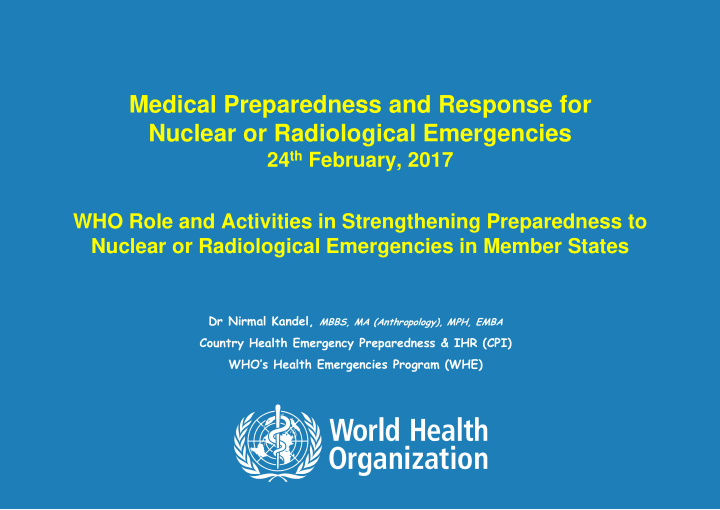



Medical Preparedness and Response for Nuclear or Radiological Emergencies 24 th February, 2017 WHO Role and Activities in Strengthening Preparedness to Nuclear or Radiological Emergencies in Member States Dr Nirmal Kandel, MBBS, MA (Anthropology), MPH, EMBA Country Health Emergency Preparedness & IHR (CPI) WHO’s Health Emergencies Program (WHE)
WHO's core functions 1. Articulate ethical and evidence-based policy positions 2. Setting norms and standards, and promoting and monitoring their implementation 3. Shaping the research agenda, and stimulating the generation, translation and dissemination of valuable knowledge 4. Providing technical support, catalysing change and developing sustainable institutional capacity 5. Monitoring the health situation and assessing health trends 6. Providing leadership on matters critical to health and engaging in partnerships where joint action is needed 2 | WHE/CPI/CME
3 | WHE/CPI/CME
4 | WHE/CPI/CME
Legal Framework pertaining to Radiation Emergences • The WHO Constitution, 1948 • Relevant World Health Assembly Resolutions • Two Conventions on Early Notification and Assistance (1987) • The International Health Regulations (IHR, 2005) • Sendai Framework for disaster risk reduction in 2015-2030 with the central focus on health 5 | WHE/CPI/CME
International Health Regulations (2005) • Legally binding treaty • 196 States Parties • In force 15 June 2007 States must prepare, report and cooperate WHO must coordinate 6 | WHE/CPI/CME
What’s new? From three diseases to all public health threats From preset measures to adapted response From control of borders to, also, containment at source 7 | WHE/CPI/CME
Core capacities requirement level - Event alert - verification Regional & International level - Assessment - Intl response - Assessment National level - Notification (24 hour basis) - P.H. response - Confirmation Intermediate level - Response - Assessment Local level - Detection of event - Reporting - Controlling 8 | WHE/CPI/CME
Core Capacity Requirements Potential Hazards 8 Core capacities – Infectious – Legislation and Policy – Coordination – Zoonosis – Surveillance – Food safety – Response – Preparedness – Chemical – Risk Communications – Radio nuclear – Human Resources – Laboratory Events at Points of Entry 3 levels – National – Intermediate – Peripheral/Community 9 | WHE/CPI/CME
Monitoring and evaluation – Reporting to EB/WHA – 195 Countries reported (2010-2015) – Review committee(s) 10 | WHE/CPI/CME
IHR (2005): a multi-hazards framework to assess core national capacities IHR (2005): Capacity to detect, assess, report and respond to all Public Health Events of International Concern Human Zoonotic Radio nuclear Chemical infectious pathogens / hazards hazards pathogens Food safety Coordination Preparedness Risk Comm. Surveillance Laboratory Legislation and Policy Resources Response Human 11 | WHE/CPI/CME
12 | WHE/CPI/CME
13 | WHE/CPI/CME
14 | WHE/CPI/CME
15 | WHE/CPI/CME
IHR Monitoring and Evaluation Framework (IHR – MEF) IHR IHR IHR M&E WH Review Commit (2005) A 58 Framework tee The IHR (2005) WHA61.2 is JEE Tool is The first JEE IHR Review is adopted by adopted. WHO developed mission is the 58 th World Committee makes develops a conducted Combining the recommendations Health framework for GHSA Action Assembly annual reporting packages and the (WHA) to the WHA IHR Capacities 2005 2015 2016 2008 2014 16 | WHE/CPI/CME
IHR Monitoring and Evaluation Framework (IHR – MEF) • Transparency Annual Reporting • Mutual accountability IHR MEF After Action • Trust building Review • Appreciation of Country plannin public health benefits g Exercises • Dialogue • Sustainability Joint External Evaluation 17 | WHE/CPI/CME
Joint External Evaluation Tool The joint external evaluation (JEE) is a voluntary , collaborative , multisectoral process to assess country capacity in order to prevent, detect and rapidly respond to public health threats. Indicators and Attributes Country Technical plannin Questions g 18 | WHE/CPI/CME
JEE Indicators for Radiation EPR 19 | WHE/CPI/CME
20 | WHE/CPI/CME
WHO's Relevant Emergency Networks Radiation Emergency Medical Preparedness and Assistance Network – WHO's technical expertise arm since 1987, more than 40 member institutions – http://www.who.int/ionizing_radiation/a_e/rempan/en/ WHO BioDoseNet (since 2007) - global network of some 90 cytogenetic laboratories specialized in biodosimetry for informal network for an information exchange and research cooperation – http://www.who.int/ionizing_radiation/a_e/biodosenet/en/ Public health emergency operations centres network (EOC-NET) 38 member states – http://www.who.int/ihr/publications/WHO_HSE_GCR_2013.4/en/ INFOSAN – The International Food Safety Authorities Network of 186 member states national food safety authorities, managed jointly by FAO and WHO – http://www.who.int/foodsafety/areas_work/infosan/en/ 21 | WHE/CPI/CME
WHO REMPAN A WHO technical expertise arm for providing to MS assistance on health interventions in radiation emergencies and on strengthening national capacities • established in 1987, originally with 4 members • today is comprised of 16 CCs, 38 LIs, and dozens of individual experts in 50 countries • meets every three years, proceedings published in peer-review journals • directory is available on the web: http://www.who.int/ionizing_radiation/a_e/rempan/en/ 22 | WHE/CPI/CME
REMPAN e-Newsletters http://www.rempan.ukw.de/aktuelles/who-rempan-e-newsletter.html 2 3 23 | WHE/CPI/CME
REMPAN-15 meeting 3 to 5 July 2017 – Geneva, Switzerland 24 | WHE/CPI/CME
Acknowledgements WHO member states International agencies, donor and Partners International Atomic Energy Agency (IAEA) WHO regional offices, WHO country offices 25 | WHE/CPI/CME
Thank You Accessible at : http://www.who.int/ihr/procedures/implementation/en/ 26 | WHE/CPI/CME
Recommend
More recommend